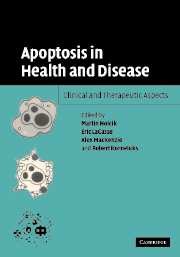Book contents
- Frontmatter
- Contents
- List of contributors
- Preface
- 1 Apoptosis in health, disease, and therapy: overview and methodology
- 2 Developmental apoptosis in health and disease
- 3 Apoptosis and cancer
- 4 Neuronal cell death in human neurodegenerative diseases and their animal/cell models
- 5 Apoptosis in the cardiovascular system: incidence, regulation, and therapeutic options
- 6 Cytotoxic lymphocytes, apoptosis, and autoimmunity
- 7 Pro- and anti-apoptotic strategies of viruses
- Index
- Plate section
- References
5 - Apoptosis in the cardiovascular system: incidence, regulation, and therapeutic options
Published online by Cambridge University Press: 03 March 2010
- Frontmatter
- Contents
- List of contributors
- Preface
- 1 Apoptosis in health, disease, and therapy: overview and methodology
- 2 Developmental apoptosis in health and disease
- 3 Apoptosis and cancer
- 4 Neuronal cell death in human neurodegenerative diseases and their animal/cell models
- 5 Apoptosis in the cardiovascular system: incidence, regulation, and therapeutic options
- 6 Cytotoxic lymphocytes, apoptosis, and autoimmunity
- 7 Pro- and anti-apoptotic strategies of viruses
- Index
- Plate section
- References
Summary
Incidence of apoptosis
Apoptosis in the heart
The adult cardiomyocyte is a terminally differentiated cell that cannot divide. Therefore, by definition, apoptosis within the adult heart cannot be physiologic, as no turnover of myocytes is possible. Indeed, apoptosis is observed very infrequently in adult hearts (Gottlieb et al., 1994; Cheng et al., 1995; Liu et al., 1995; Kajstura et al., 1996; Sharov et al., 1996; Bialik et al., 1997). In contrast, cardiomyocyte apoptosis in development plays a critical role in formation of the heart, and is an increasingly important feature of many diseases of the cardiovascular system (Table 5.1).
Apoptosis in cardiac development and aging
During development, organs and tissues are remodeled using the processes of cell division, cell migration, and cell death. Most, if not all, of this cell death occurs through apoptosis. Thus, apoptosis is seen when the notochord fuses in the developing spinal cord and apoptosis causes the breakdown of interdigital webs to sculpt the fingers (see Chapter 2). Within the heart, cell death may be involved in the formation of septa between cardiac chambers or of valves, suggesting that defects in apoptosis can result in congenital heart disease (Krstic and Pexieder, 1973; Pexieder, 1975). Major foci of apoptosis include the atrioventricular cushions and their zones of fusion, the bulbar cushions and their zones of fusion, and the aortic and pulmonary valves and arteries (Pexieder, 1975; Cheng et al., 2002). Indeed, apoptosis has been found in the developing rat bulbus cordis within mesenchymal cells (Takeda et al., 1996).
- Type
- Chapter
- Information
- Apoptosis in Health and DiseaseClinical and Therapeutic Aspects, pp. 156 - 187Publisher: Cambridge University PressPrint publication year: 2005



